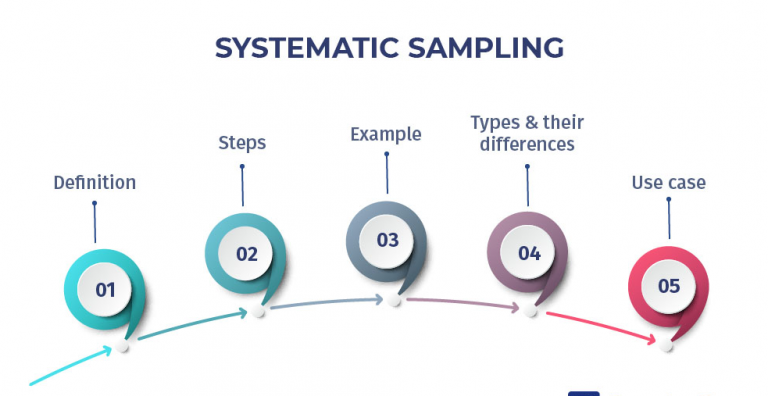Systematic sampling is a kind of probability sampling technique wherein pattern participants from a bigger populace are decided on in step with a random start line however with a hard and fast, periodic c language. This c language, known as the sampling c language, is calculated via way of means of dividing the populace length via way of means of the preferred pattern length.
Despite the pattern populace being decided on in advance, systematic sampling continues to be notion of as being random if the periodic c language is decided in advance and the start line is random.

How Systematic Sampling Works
Since easy random sampling of a populace may be inefficient and time-consuming, statisticians flip to different techniques, which include systematic sampling. Choosing a pattern length via a scientific technique may achieve quickly. Once a hard and fast start line has been diagnosed, a consistent c language is chosen to facilitate player choice.
Systematic sampling is most excellent to easy random sampling while there may be a low chance of information manipulation. If this kind of chance is excessive while a researcher can manage the c language period to gain preferred effects, a easy random sampling method could be greater appropriate.
More details
Systematic sampling is famous with researchers and analysts due to its simplicity. Researchers typically expect the effects are consultant of maximum normal populations except a random function disproportionately exists with each “nth” information pattern (that’s unlikely). In different words, a populace desires to show off a herbal diploma of randomness alongside the selected metric. If the populace has a kind of standardized pattern, the chance of by accident deciding on very not unusual place instances is greater apparent.
Within systematic sampling, as with different sampling techniques. A goal populace should decide on previous to choosing members. A populace may diagnosed primarily based totally on any wide variety of preferred traits that in shape. The motive of the examine conduct. Some choice standards might also additionally consist of age, gender, race, location, schooling degree and/or profession.
Examples of Systematic Sampling
As a hypothetical instance of systematic sampling. Expect that during a populace of 10,000 human beings. A statistician selects each a centesimal man or woman for sampling. The sampling periods also can be systematic. Which include deciding on a brand new pattern to attract from each 12 hours.
As every other instance, in case you desire to pick a random organization of 1,000 human beings from a populace of 50,000. The usage of systematic sampling. All of the ability members should locate in a listing and a start line could decide on. Once the listing is form. Each fiftieth man or woman at the listing (beginning the counted number at the chosen start line). It could selected as a player, due to the fact 50,000/1,000 = 50.
For instance, if the chosen start line became 20, the seventieth man or woman at the listing. It could select via way of means of the 120th, and so on. Once the stop of the listing became reached and if extra members require. The counted number loops to the start of the listing to complete the counted number.
Systematic Sampling Versus Cluster Sampling
Systematic sampling and cluster sampling vary. In how they pull pattern factors from the populace covered within side the pattern. Cluster sampling breaks the populace down into clusters. Even as systematic sampling makes use of constant periods from the bigger populace to create the pattern.
Systematic sampling selects a random start line from the populace. After which a pattern take from normal constant periods of the populace relying on its length. Cluster sampling divides the populace into clusters. After which takes a easy random pattern from every cluster.
Cluster sampling is take into consideration much less particular than different techniques of sampling. However, it can shop prices on acquiring a pattern. Cluster sampling is a two-step sampling procedure. It can use while finishing a listing of the complete populace is tough. For instance, it is able to be tough to assemble the complete populace of the clients of a grocery save to interview.
Two Cents
Systematic Tasting – as the name recommends, this technique uses a very organized strategy to attract an example from the populace. Mean a survey research study has a crowd of 10,000, and the survey study pro would like to draw an example of 200 from this population. Firstly separate the population size by the desired sample size to result in what is called sampling ratio. In our picture, the sampling ratio will be 50 (10,000 divided by 200). Currently, select any arbitrary number between 1 as well as 10. Let’s say 4 is that number. Now include sampling quotient to this number. The result will undoubtedly be 54 (4 + 50). Now add 50 once more to this number to get 104 and so forth. One needs to continue including the sampling ratio to the resultant number.
Hence, the sample will undoubtedly consist of person/ team/ company number 4, 54, 104, etc. A key issue faced with this method is the accessibility of the tasting framework (list of populace elements) and its constitution. Constitution will make a substantial distinction to the final sample listing. For example, if the names of all the ladies in a list have a salutation Ms., they will be clustered together. On the other hand, if they are scattered across the list (A to Z), their possibility of getting selected in the sample will vary.



